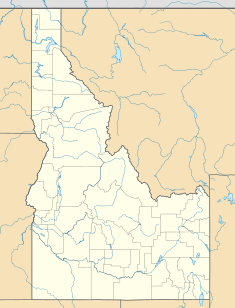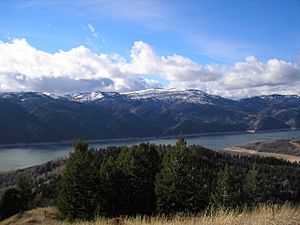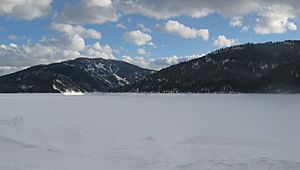Palisades Dam facts for kids
Quick facts for kids Palisades Dam |
|
|---|---|

Palisades Dam and Reservoir
|
|
|
Location of Palisades Dam in Idaho
|
|
| Official name | Palisades Dam |
| Location | Bonneville County, Idaho, USA |
| Coordinates | 43°19′59″N 111°12′10″W / 43.33306°N 111.20278°W |
| Construction began | 1951 |
| Opening date | 1957 |
| Operator(s) | U.S. Bureau of Reclamation |
| Dam and spillways | |
| Impounds | Snake River |
| Height | 270 feet (82 m) |
| Length | 2,100 feet (640 m) |
| Dam volume | 13,571,000 cu yd (10,376,000 m3) |
| Spillway type | Radial gates to tunnel through left abutment |
| Spillway capacity | 48,500 cu ft/s (1,370 m3/s) |
| Reservoir | |
| Creates | Palisades Reservoir |
| Total capacity | 1,200,000 acre-feet (1.5 km3) |
| Catchment area | 5,150 sq mi (13,300 km2) |
| Normal elevation | 5,620 ft (1,713 m) |
| Power station | |
| Hydraulic head | 249 ft (76 m) |
| Turbines | 4 x 44.15 MW turbines |
| Installed capacity | 176.6 MW |
| Annual generation | 906,720,100 KWh (1994) |
The Palisades Dam (National ID # ID00273) is a huge earth-fill dam on the Snake River in Bonneville County, Idaho, USA. It was finished in 1957. This important dam helps control floods, provides water for farms, and offers fun places for people to visit. It also has a powerful hydroelectric power plant that can make a lot of electricity. The big lake created by the dam is called Palisades Reservoir, and it holds a massive amount of water. In 2018, the dam and its power station were added to the National Register of Historic Places, which means they are important historical sites.
Why Was It Built?
The Palisades Dam was built by the U.S. Bureau of Reclamation as a major part of the Palisades Project. This project was designed to help the Snake River area. It added to earlier projects like the Minidoka Project, which also helped with farming and power.
The main goal was to store water. This was especially important because the area had faced serious droughts in the 1930s. The dam helps save about 1.35 million acre-feet of water during winter. This water is then used by farmers during the growing season.
Building the Dam
Engineers started looking for a good spot to build the dam in 1934. They chose a narrow part of the Snake River canyon called Calamity Point. This spot had tall, 1,000-foot walls, making it perfect for a dam.
Construction of the dam began in 1951. It was a huge job! The Palisades Dam was the biggest dam built by the U.S. Bureau of Reclamation at that time. It used 13,571,000 cubic yards of material. The dam was completed in 1957, and the power plant started making electricity the next year.
Powering Up
The dam has a hydroelectric power plant with four turbines. These turbines can create 176.6 megawatts of electricity. Much of this power is used to pump water for farming in the Minidoka Project. Any extra power is sold to other users. The power plant was made even stronger in 1994, increasing its capacity to make more electricity.
In 1950, the U.S. Congress approved the project. They decided that the dam would help with many things. Its main jobs would be to store water for farms and control floods. Making electricity would also be an important part of its work.




